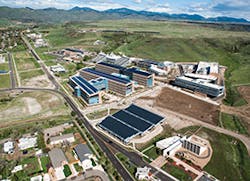Adopting a Whole Building Systems Approach to Energy Efficiency
A new approach is needed to advance energy efficiency in buildings. A multitude of trends and innovations offer new opportunities for progress increasingly converging on the prospect of a new basic concept: whole building systems. Although concentrating on incremental component efficiency has yielded strong results to date, and may yield further incremental, small improvements, a holistic whole building strategy promises to be a game changer-and the path to significant building energy efficiency. An industry shift to whole systems efficiency offers the first step toward a transformation in buildings to parallel what has been witnessed in telecommunications, logistics, and other reengineered industries.
History repeatedly demonstrates that innovation and progress often stem from the convergence of several, sometimes random and unrelated trends in technology. Today, such trends include low-cost natural gas, practical building-scale combined heat and power systems, heat/energy-recovery in water heating and ventilation systems, economically viable solar voltaic generation, smart grid and energy storage, and variable-speed HVAC equipment that saves energy and could adapt to fluctuations in renewable power generation and respond to utility peak-load conditions. Practical and effective building control systems tying these developments together could substantially reduce energy usage and stress on the electric grid, and ensure that buildings continue to operate properly.
NOTHING FOUNDHowever, leveraging these opportunities requires a shift in focus-away from squeezing more energy out of equipment components to capitalizing on the relationship among systems where the greatest building energy efficiency opportunities exist. It also requires a change in the way buildings are designed, and requires collaboration between all players in the building design and construction-in essence, a new “building delivery system.”
A section of the HVAC system in the new CBEI building at the Philidelphia Navy Yard
Component Efficiency and the “Max-Tech” Challenge
Thanks to advances in technology and improved building standards, the HVAC and building industries have made significant progress in reducing energy consumption in commercial buildings. Chiller refinements have lowered annual energy usage by as much as 59% in the ASHRAE 90.1 standard relative to the first ASHRAE 90 standard in 1975. Commercial rooftops have also improved 45% in the same time period. Focus by the states and broader adoption of ASHRAE 90.1-based building energy codes are helping to make such technological advancements common.
Moving forward, some incremental efficiency improvements can continue to be made in discrete pieces of equipment; however, the industry is approaching the “max-tech” level, where the laws of diminishing returns limit further significant improvement. The use of annualized metrics offers additional energy saving opportunities, but these, too, will soon approach technical limits. To exploit technology advancements achieved to date, building codes need to adopt the latest minimum ASHRAE 90.1 standard and enforce it. It is estimated that 30 to 45% of energy could be saved by adopting and enforcing ASHRAE 90.1-2010 and ASHRAE 90.1-2013 nationwide, compared to what has been possible with the 2004 version of the standard. While our federal and state political institutions are grappling with this vast untapped opportunity, industry is already looking ahead to the next big prospect for energy savings.
The Evolution of Efficiency Regulations
Since efficiency requirements were established in the 1970s, the primary focus of efficiency regulation has been the full-load ratings metric of the various HVAC components used in buildings. Regulators find these metrics easy to use and measure and try to treat commercial HVAC equipment like appliances. However, commercial buildings seldom, if ever, run at full load and design ambients, and full-load metrics are not always representative of the annualized equipment energy use.
New metrics developed for some HVAC products better represent annualized performance, but they continue to be defined at a component level. Both the full- and part-load metrics are approaching technological limits and significant further improvements are unlikely. Nevertheless, within most commercial buildings, opportunities exist to improve the overall system efficiency.
These opportunities rely on the following concepts:
- minimizing the envelope losses and overall load in the building,
- reusing energy within the building and exchanging energy with buildings in a complex or campus,
- using hybrid systems that increase the overall efficiency of the equipment on an annual basis with technologies selected to optimize the performance on an annual basis,
- using thermal and electrical storage,
- using low-grade energy sources, like geothermal and waste heat,
- using renewable energy,
- using outside air ventilation more effectively,
- using building automation and advanced system controls and diagnostics for commissioning and continuous commissioning, and
- considering efficiency labeling at the whole building level with more data disclosure so tenants and buyers can make informed decisions.
Moving to this next step in energy savings requires a close examination of the building and building complex as a system. The solution is tied to whole building system-based annual efficiency. To that point, the Department of Energy (DOE)-sponsored Hubs are beginning to lead by example.
Detail from the HVAC system
The Whole Building Systems Approach in Practice
DOE’s Consortium for Building Energy Efficiency, or CBEI (formerly known as the Energy Efficient Building Hub or EEB HUB) at the Philadelphia Navy Yard serves as a test bed for whole building systems innovation. Established with a $130 million department grant, CBEI has as its immediate goal the delivery of the means and methods to reduce energy consumption in commercial buildings by 20 percent by 2020 and drive the building sector to its full energy efficiency potential through system integration, advanced building modeling, commissioning, maintenance and management, and demonstration projects deploying market-proven technologies.
As another example, the National Renewable Energy Laboratory (NREL) in Boulder, CO, operates one of the largest near-net-zero-energy office buildings in the world. This office building demonstrates how building envelope and operating systems link together to efficiently produce, utilize and reutilize energy.
It is important to note that a holistic approach to buildings is not a new or unproven concept. First identified and developed by a Joint Working Group (WG) for the International Organization for Standardization (ISO) technical committee TC 163/205, this approach is now the basis of the second European mandate for energy efficiency in buildings, which is being addressed by CEN, the European Committee for Standardization, with anticipation for inclusion in ISO. The Building Energy Performance (EP) is supported by a number of ISO committees and standards that provide the structure to achieve the goal. Similar approaches also are being used for high-end green buildings, but are not the norm for the standard building in the United States. In order for this to be fully realized in the industry, equipment manufacturers need to get involved, which is the reason for the Air-Conditioning, Heating and Refrigeration Institute’s Systems Efficiency Working Group and other similar initiatives. If done correctly, there is every reason to think that new metrics and approaches will find their way into building standards and codes to properly characterize the performance of systems and help pave the way to nearly net-zero-energy buildings.
Taking Action: A Multi-Pronged Plan
The move to a whole building system approach to energy efficiency is not easy. It will require new tools to determine system performance, which may present challenges to building officials and regulators accustomed to single, prescriptive, minimum metrics. It will also require new system level ratings for equipment that combine subsystem and system levels. It also will require changes to federal law which currently focuses on single metrics, most of which are at full load. In addition, the move will demand greater focus on building commissioning and maintenance to ensure that equipment is working well as part of a system and over the life of the product.
At the same time, facilitating the transition to energy optimization and a whole building system approach requires the removal of barriers, disincentives, and distractions, including:
- unrealistically long 39-year US tax depreciation on mechanical systems, which discourages investment and exacerbates a focus on first cost
- regulators’ focus on incrementally increasing minimum efficiency standards or expanding them to a broader range of discrete components, which often provides diminishing returns while distracting focus from larger opportunities in building systems integration and development of new innovative systems approaches
- opposition to building energy rating systems, which discourages market-based competitive pressures to enhance building energy performance
- market approaches using tenant billing where there is no incentive to invest in new efficiency approaches
- longer than conventional payback periods and lack of effective financing mechanisms to support the upgrade of existing buildings and equipment, especially for investments where building occupants are not the building owners
Finally, the path forward requires convening all relevant stakeholders, including building owners, investors and brokers, and defining the value proposition associated with a whole building systems approach to energy efficiency, creating awareness and educational opportunities around the approach and promoting regulatory efforts that support it. To move from equipment to systems, AHRI has established a Systems Efficiency Working Group, with members representing a cross-section of HVAC manufacturers. The group will explore how to move to the next step in the pyramid and provide information and data in a way that can support all Total Building Efficiency methodologies, such as The ASHRAE Building Energy Quotient.
Furthermore, its initial steps include the evaluation of new annualized metrics, and the development of new systems tools, new ratings for the complete equipment operating map and new ratings systems for hybrid units.


